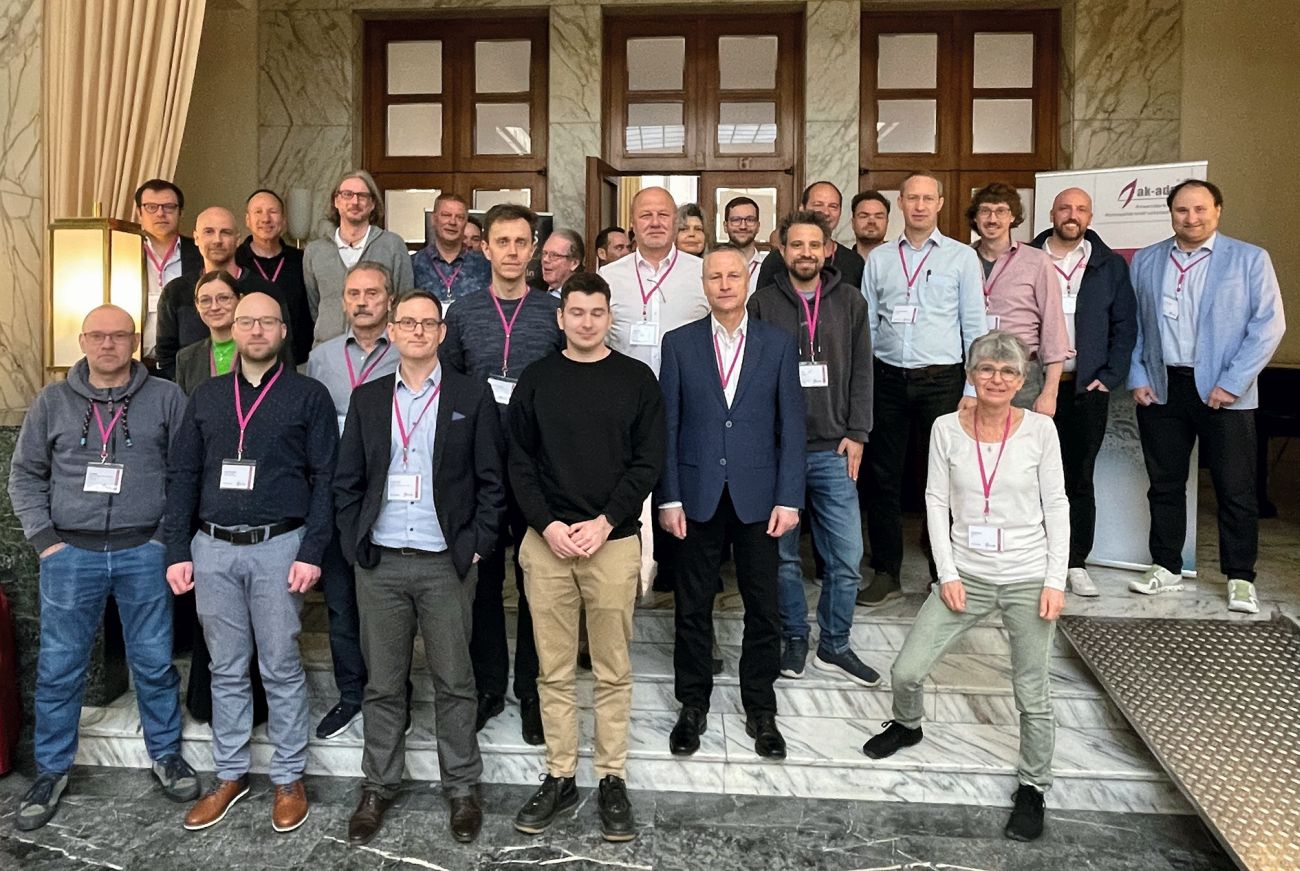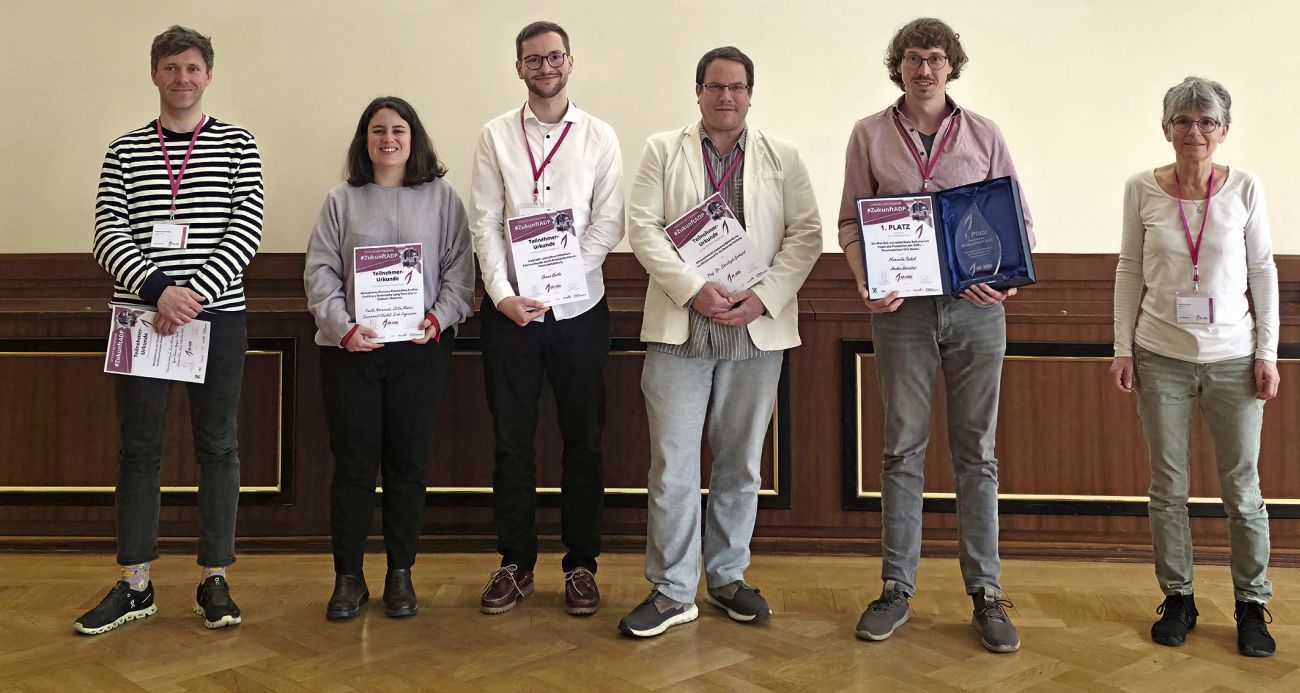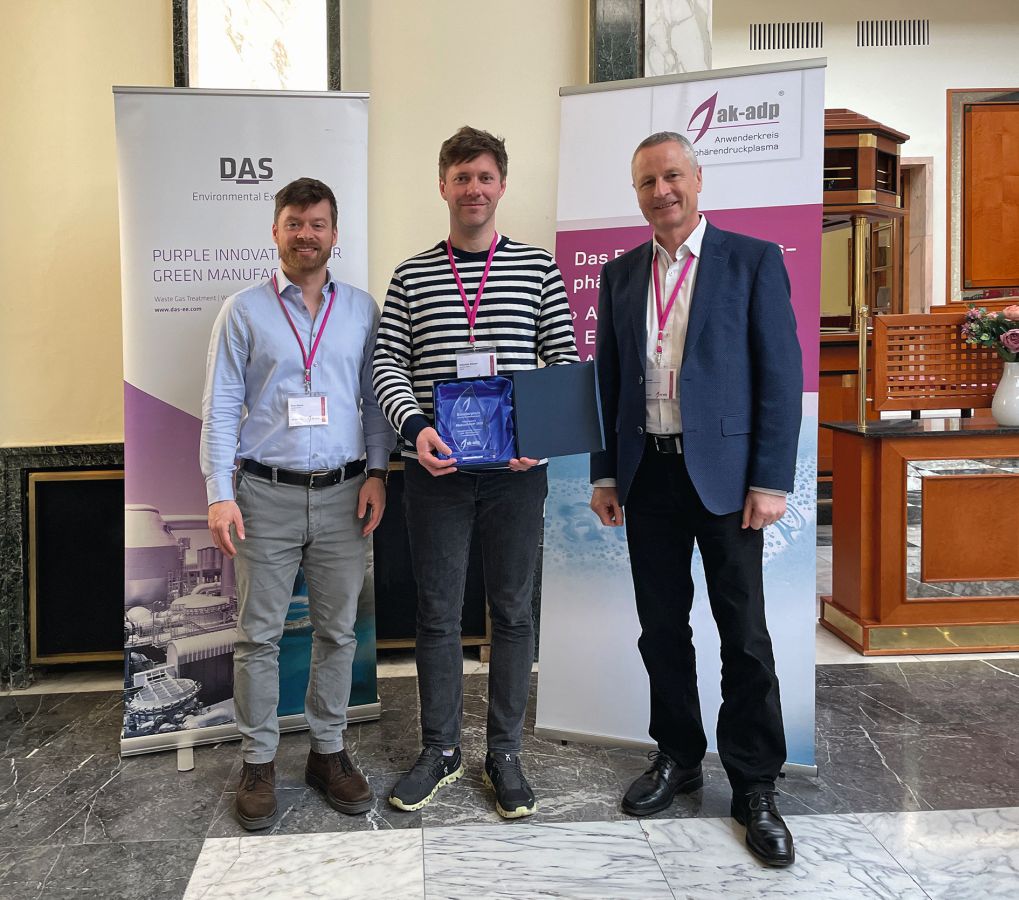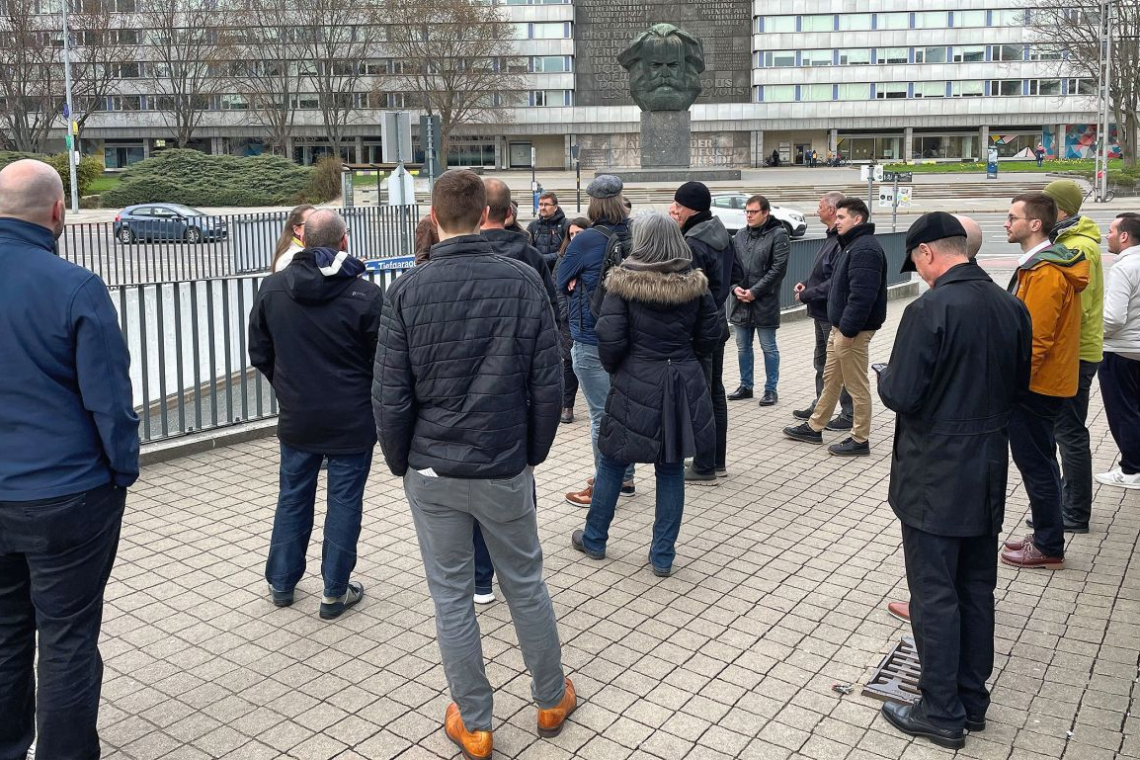By combining technologies, their range of applications can be significantly expanded. Various examples of combining atmospheric plasmas with other technologies were presented and discussed at the 48th workshop of the atmospheric pressure plasma user group (ak-adp) in Chemnitz from April 9 to 10, 2025. Plasma experts and users from Germany, Austria and Switzerland came together for the event.
The presentations presented for discussion focused on cleaning and joining processes, applications of atmospheric pressure plasmas for sterilization, disinfection and broad antimicrobial effects, gas barrier coatings, new approaches to thin-film PV production and plasma-assisted surface pretreatment of aluminium die-cast components. The topic of "Atmospheric pressure plasma and AI - a symbiosis for the future!" was also taken up again and continued in an application-oriented manner.
A particular highlight of the workshop was the continuation of the #ZukunftADP competition with the presentation of the competition ideas submitted in 2025. The competition has been held every two years since 2021. Cups and prize money are awarded for the best entries.
 Around 30 participants at the event
Around 30 participants at the event
The presentations
Sergey Stepanov, Fraunhofer IFAM Bremen, provided examples of "Combinations of inline cleaning processes with atmospheric pressure (AD) plasmas for reliable adhesion of coatings and adhesives". The advantages of AD plasmas are manifold, including the fact that they can be integrated into inline processes. Both spot and large area treatments are possible, costs and space requirements are moderate and the dry AD process requires no post-treatment. For the pre-treatment of highly contaminated surfaces, a combination with vacuum suction blasting,CO2 snow cleaning or laser treatment is possible. The speaker presented the process principles and explained the advantages and limitations of the individual processes.
Julian Kraft, Fraunhofer ICT, Pfinztal, reported on "Processes for the sustainable joining of plastic hybrid materials". The SiO2-based adhesive coatings developed at the ICT make it possible to produce hybrid components with technically usable interface strengths in the injection molding process without the use of primers. The columnar SiO2 pore structure created by the coating is infiltrated with a polymer melt, for example, which then solidifies and thus enables a force-fit connection. Since only some of the possible columnar structures have the necessary properties (porosity, column diameter and height, internal strength, etc.), the optimum parameter space for atmospheric pressure deposition was determined. Measurements of the interfacial strength yielded values up to >20 MPa. The measured bond strengths are comparable to those that can be achieved in the low-pressure process and differ significantly from the values of uncoated samples.
Medicine
In his paper "Combination of cold atmospheric plasma and plasma-activated water in the context of sterilization and disinfection", Christian Bäuml, relyon plasma GmbH, Regensburg, presented the latest plasma technology. The MediPlas system consists of two components, the MediPlas Reactor and the MediPlas Driver. The reactor can be used to generate reactive oxygen and nitrogen compounds (RONs, ozone, hydrogen peroxide, nitrogen oxides) in a dielectric barrier discharge (HDBD, Hybrid Dielectric Barrier Discharge). The composition and concentration of the RONs in the gas mixture can be influenced via active power and temperature control. The driver is the high-voltage generator optimally adapted to this. Using the example of plasma-activated water produced with the MediPlas, which can be used for sterilization and disinfection, the lecturer was able to demonstrate the possible applications. Studies showed that, depending on the duration of treatment, a reduction in the live cell counts of gram-positive and gram-negative bacteria of more than 6 log levels could be achieved.
"Antimicrobially active cold plasma spray coatings for contact and contamination surfaces" was presented by Adrian Würzl, Innovent e.V., Jena. Ceramic-metallic cold plasma-sprayed Al2O3coatings with 2.5% copper have a long-term antibacterial and antiviral effect that is retained even after washability and leaching tests. They can also be applied to rough surfaces with good adhesion and abrasion resistance. Porosity, abrasion resistance and layer thickness can be specifically adjusted.
Energy technology
The "Production of gas barrier coatings using atmospheric pressure plasmas and photochemical processes" was described by Patrick With, Leibniz Institute for Surface Modification e.V. (IOM), Leipzig. Gas barrier coatings play a key role in the use of renewable energies. They protect sensitive technologies such as flexible solar modules from environmental influences and thus extend their service life. In the hydrogen economy, they enable the safe storage and transportation of hydrogen. Instead of using complex sol-gel processes for precursor conversion, the lecturer reported on photoconversion with high-energy (V)UV light or atmospheric pressure plasmas. Photoconversion, for example, can be used to produce amorphous TiOx or FexOy metal oxide thin films. Both plasma jets and planar dielectric barrier discharge (DBD) sources are suitable for plasma conversion. SiOx films produced in this way make it possible to reduce the oxygen transmission rate (OTR) by an order of magnitude. Further improvement through technology development seems realistic.
Adhesion
Glass syringe barrels are coated with a baked-on siliconized (EBS) coating for various reasons (reduction of sliding friction, increased chemical resistance, stability, break resistance, water-repellent surface). The coating reduces the adhesion of adhesive joints of the cannula. In his paper "Plasma-induced coating post-processing - modification and removal of baked-on siliconized coatings on glass substrates", Daniel Tasche, HAWK Göttingen, was able to show that plasma treatment increases the adhesion of adhesive bonds due to the chemical change in the surface. The atmospheric non-equilibrium plasma removes carbon from the surface and accumulates oxygen from the surrounding atmosphere. The plasma treatment leads to the vitrification of EBS layers (polydimethylsiloxane, PDMS), which are converted into SiO2. The tensile strength of a bonded cannula increases up to a plasma treatment time of 300 seconds and then reaches saturation. Simultaneous treatment of a tray with 176 syringe barrels was used as an example to demonstrate scalability.
Peter van Steenacker, Tigres GmbH, gave an overview of the topic "Technology tool atmospheric pressure plasma - versatile combinations in industrial applications". Today, plasma nozzle systems (plasma jets) can be designed in various output sizes, with adjustable output, different nozzle shapes or attachments as well as multi- and rotary nozzles, with different process gases and for plasma coating. Further advantages for many applications are a practically potential-free plasma, a low plasma temperature and moderate energy consumption. Compared to DBE corona technology, it is also possible to work without counter electrodes. Using the example of Sita Bauelemente, a specialist in construction and roof drainage, von Steenacker was able to show how plastic and rubber roofing membranes can be treated efficiently and evenly using plasma to improve their adhesion properties. Previously, this step was carried out by manual priming - a labor-intensive process that also poses health risks.
Industrial surface modification
Simon Chwatal, INO GmbH, Attnang-Puchheim, Austria, demonstrated the broad application potential of plasma processes using "Two examples of industrial surface modification with atmospheric pressure plasma - new approaches to thin-film PV production and plasma-assisted surface pretreatment of die-cast aluminum components". By using INO plasma systems, advantages such as faster crystallization, increased efficiency, environmental friendliness due to lead-free materials and scalability are achieved in the production of perovskite thin films. However, contaminated die-cast aluminum components (e.g. milled AW6082) can also be cleaned or activated by plasma to improve the adhesion of bonds and coatings.
"Applications of atmospheric pressure plasmas in molecular synthesis: data-driven experiments and simulations" was the topic of the presentation by Dave Ahrens, enaDyne GmbH, Leipzig. In order to be able to processCO2, for example, at low cost, the company is pursuing the approach of non-thermal plasma catalysis, in which molecules are excited by electrically generated cold plasma. This makes chemical synthesis considerably easier and enables the production of "green" basic chemicals such as ethylene or e-fuels without any energy losses, for example due to waste heat. For the targeted excitation of the gas species by plasma, a large number of parameters involved must be precisely coordinated. To this end, EnaDyne uses advanced regression algorithms to model the complex processes. The presentation showed examples of how a data-driven, time-efficient experimental design can be set up. The efficient exploration of the data space is also expected to reduce the development time to 20 to 40 % of the time that would be expected with a random, iterative approach.
 Awarding the competition participants
Awarding the competition participants
#FutureADP: Award ceremony for the competition participants
The highlight of the workshop was the award ceremony for the #ZukunftADP 2025 competition with a presentation of the entries.
Every two years since 2021, the competition has offered the opportunity to submit small and large ideas, concepts and best practices on atmospheric plasmas in relation to
- Innovative product development
- Generation of new surface properties
- Environmental protection & sustainability
- Energy saving & energy generation
- Medical technology and health aspects
and discuss them with experts and potential users. The content of the contributions will be evaluated by a jury of senior professors, young scientists, industry representatives and the trade press.
In particular, students, doctoral candidates, researchers and industry representatives are invited to take part, as well as doers/inventors and plasma enthusiasts with other professional backgrounds.
The company DAS Environmental Expert (EE) GmbH has also donated a special prize as part of the 2025 competition, which is explicitly intended to honor the sustainability aspect of innovative plasma solutions. DAS EE develops and sells environmental technology systems for cleaning exhaust air and wastewater in the high-tech industry, thereby contributing to improved sustainability in this sector. Atmospheric plasma is establishing itself in this segment as an alternative energy source for treating harmful gases, which will replace natural gas-powered burners in the medium term.
All of the competition entries submitted have demonstrated approaches and solutions with which plasma applications can contribute to improving sustainability. The competition jury awarded consistently high marks for the reduction of environmental pollution and the achievement of climate neutrality. The diverse fields of application of the entries ranged from the reactivation of catalytic converters to improved car batteries, the functionalization of desert sand for industrial applications and the separability of film composites.
The winner of the consistently very interesting and creative ideas with economic relevance was the work of Manuela Ockel, FAU Erlangen-Nuremberg, Chair of FAPS, and Andre Borchers, Fraunhofer IKTS Forchheim, on the topic "The disadvantage of solid-state batteries is (still) the production of SSBs - plasma spraying solves this", as voted by the jury from plasma research, industry and the trade press. The special prize for sustainability was awarded to employees of the company enaDyne from Leipzig. They were able to improve the effectiveness of their non-thermal plasma catalysis system through simulation. With this system, enaDyne offers a practical process for the energy-efficient destruction of harmful gases and the production of synthesis gases.
Between the lecture sessions and at the evening get-together, the workshop participants had ample opportunity for lively discussions and conversations. Establishing and maintaining contacts is an important part of ak-adp's work. A guided city tour through Chemnitz added to the impressions and information on the past and present of the European Capital of Culture 2025.
 Presentation of the special prize
Presentation of the special prize
Summary
Both the current technology developments with atmospheric plasmas presented and, in particular, the new competition entries from the #ZukunftADP 2025 competition show the future potential of plasmas at normal pressure for technical developments in all branches of industry. Material modifications and surface functionalizations contribute to sustainable energy generation, battery development, packaging optimization, recycling, building material supply, surface design and much more. Forward-looking production management and quality assurance through machine learning and AI are also playing an increasingly important role.


